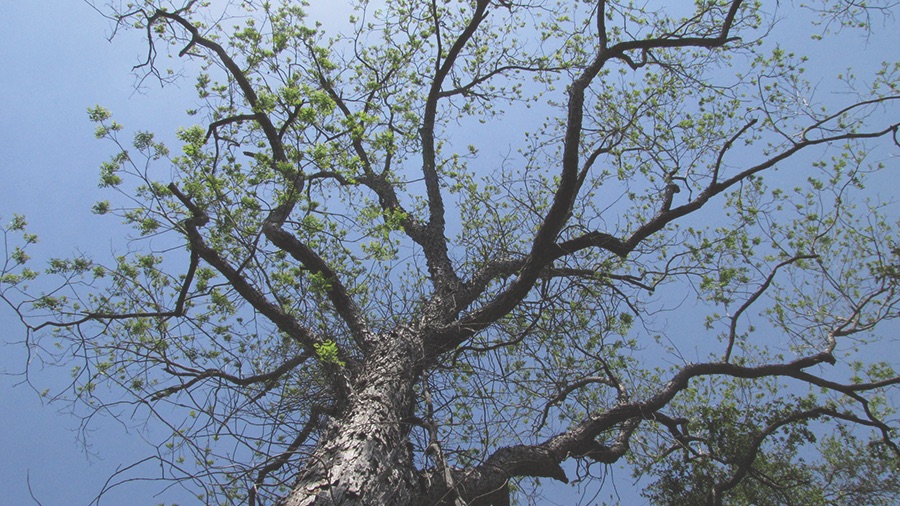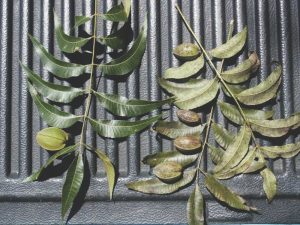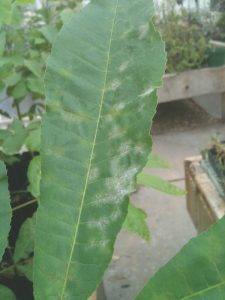Early season fungicides – a sound investment

This photo depicts the parachute stage, or leaf-burst stage of pecan tree foliage growth in the spring. (Fig. 1)
Pop-up showers and thunderstorms can happen seemingly out of nowhere when the humidity and temperature are high in early summer. Even more problematic are low-pressure systems and tropical weather that bring days and nights of rain and give the sun little opportunity to return leaves and shucks to their previously dry state. The saying that “an ounce of prevention is worth a pound of cure” should be taken to heart by pecan growers in high humidity regions. Preventing a disease from ever happening is more effectively accomplished with the pecan fungicides available today than curing one after the damage has begun, and many pecan orchards have been hurt by skipping early season fungicide sprays.
What to Prevent:
Precipitation, warm temperatures and high relative humidity are drivers for foliage and nut diseases on pecans. Pecan scab is rightfully considered the most important pecan disease in the world, because of its ability to cause severe crop loss as well as defoliation. Scab can be damaging over a 120- to 150-day period beginning as soon as the trees break dormancy in the spring. Because scab has been studied more than any other pecan disease problem, we know more about timing fungicide sprays for scab correctly and how to reduce sprays when the weather is not conducive to this polycyclic (many cycles) disease.
The AU Pecan program described fully at has been successfully used to extend the time between fungicide sprays and to delay the timing of the first fungicide spray until the parachute stage is reached if weather parameters don’t trigger it before then (Bertrand and Brenneman, 1998). While the goal of AU Pecan is to save sprays, it is noteworthy that the Georgia plant pathologists that developed this program believed that no trees should go completely unsprayed using the AU Pecan program. The parachute stage, also called “leaf burst stage” (picture 1) is usually reached within 10-14 days of bud break, depending on March/April temperatures.
A standard calendar-based spray program for pecan disease control calls for sprays during the prepollination period (bud break to nut set) every 10-14 days for pecan scab and downy spot (Brock and Brenneman, 2012 Georgia Pecan Spray Guide). Downy spot is an important disease to prevent in a pecan orchard (Picture 2). This fungus infects foliage early in the year, from April to June, causing leaves to drop off early in the fall. Infected leaves initially have pale yellow splotches that later take on a frost-like or downy appearance. A 20-percent level of DS infection on pecan leaves can cause a 40-percent loss of photosynthetic energy production in those same leaves – a significant and damaging effect.
Powdery mildew can be damaging to developing pecan foliage in the early summer months, causing leaf stunting and distortion (picture 3). Although full-sized, pecan nuts in latter stages of maturity can tolerate PM infection, small and growing pecans may abort or not reach maximum size for the variety.
Other foliage diseases to prevent include vein spot, zonate leaf spot, leaf blotch, brown spot, and others. While some of these problems are minor threats in their own right, their cumulative effects create diseased and unhealthy foliage. The ‘Elliott’ leaves in picture 4 are a great example of the outcome of not spraying fungicides in a pecan orchard. It is important to point out that the leaves depicted have no scab infection. Rather, they are inundated with downy spot, leaf blotch and other minor fungi.

The ‘Elliott’ leaves on the left were sprayed with fungicide. Those on the right were unsprayed and were inundated with downy spot, leaf blotch and other minor fungi, but no scab.
Risky Rationale
Pecan growers in the Southeast should avoid falling victim to the “wait and see if we set a crop” management strategy. This approach is sometimes taken by growers coming off a large on-year with low prices who don’t want to take the second hit of expending inputs on a light or blank crop. It’s an understandable mindset, but one priority for a manager facing an off-year is to prepare the trees in the orchard for the next on-year. Poor foliage condition and early leaf drop will result in fewer stored carbohydrates to set and develop the next on-year crop, so yield and nut quality may be reduced. If sprays are delayed until the appearance of the female flowers or even later to ensure that the nuts set, the infections of some of the aforementioned diseases may have already begun, especially downy spot, which essentially cannot be controlled after the damage appears. It must be prevented.
Prevention Strategy
Using both the Georgia Spray Guide and the AU Pecan Scab Control Model as guidance documents, the appropriate management strategy for pecan disease management is to spray fungicides early in the prepollination period (no later than parachute stage) as an investment in good foliage condition that will pay dividends next year, if not in both the current and following crop years. Chemical cost and application cost (labor, fuel, equipment maintenance) can combine to cost anywhere from $25 to $40 per acre for a single fungicide treatment. That single well-timed and well-delivered fungicide spray can provide tremendous disease prevention capability to new pecan leaves for many weeks. Due to the rapid addition of new leaves in the early spring, a second and third application may be advisable to ensure that the majority of new leaves produced this spring are protected.
Fungicides for pecan disease prevention are not cheap, but there are several high-quality products available today to choose from, and the cost varies among them. Orchards with any appearance of downy spot or other diseases in the previous year should consider the DMI (triazole) class fungicides-FRAC Group 3; the strobilurins-Group 11, and thiophanate methyl-Group 1. Triphenyl tin hydroxide-(Group 30) materials help prevent foliage diseases but are best tank-mixed with one of the other groups if desired for use in the pre-pollination period if these diseases have been a problem or if weather conditions become conducive to high disease pressure. For a very current and thorough database of pecan fungicides visit Pecan ipmPIPE’s website, where there is also information on fungicide resistance management by Texas A&M’s Tom Isakeit.
Healthy pecan leaves are the cornerstone to a successful pecan season. Early spring infections of pecan scab can result in greater pressure on the nut crop; even severe crop damage in a rainy year. Early infection by downy spot, powdery mildew and other fungi can result in diminished foliage capacity, weaker trees, premature defoliation and lost crop potential. In the Southeast, rain and humidity is the “norm” and unprotected pecan leaves are only one good rain shower away from a potentially damaging infection.


